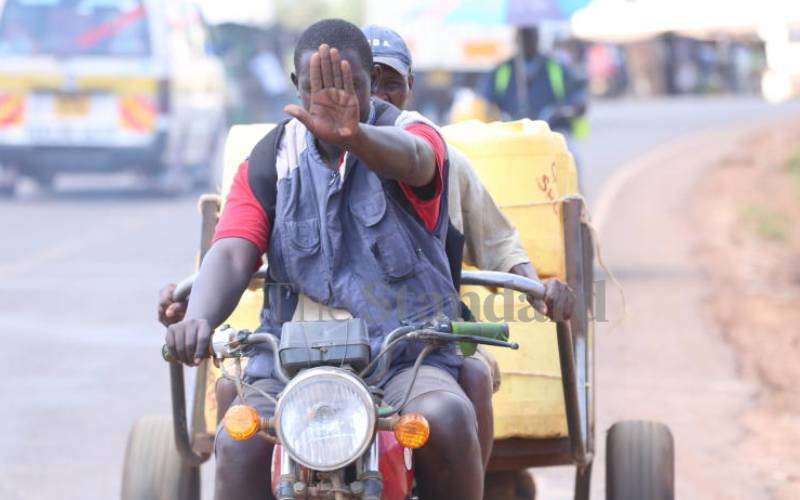By Edwin Cheserek
KENYA: The country is yet again staring at a food crisis after thousands of hectares of maize in the breadbasket regions were destroyed.
Even as the Ministry of Agriculture mandarins put a brave face and assure Kenyans that all is well in terms of food security, there are fears that maize production in some parts of South, Central, and Eastern Kenya could decline by as much as 60 per cent.
This follows the outbreak of a disease identified a Maize Lethal Necrosis that is a relatively new viral crop disease transmitted by insects.
According to a study carried out by the Food Agricultural Organisation of the United Nations in July,last year, at least 64,000 hectares of land under the crop had been destroyed.
It is estimated the country will face a shortfall of over one million bags of maize, something that could precipitate a crisis.
Already the Government has set up a taskforce with the brief of recommending ways to mitigate the effects of the disease.
The outbreak was so devastating that Kenya Agricultural Research Institute (Kari) recommended enforcement of quarantine procedures as a short-term strategy to reduce the impact of the disease.
The viral disease was first reported in Bomet County in the South Rift before it spread to Kericho and Nyamira counties. Its signs were also reported in the North Rift.
Kenya Farmers Association director Kipkorir Menjo reckons that the disease is far from over and advised farmers about the importance of crop rotation.
He said since farmers complained about the ‘mysterious’ disease, solution to the crisis are yet to be found. “The response by the Ministry of Agriculture, which seems to have been caught off guard, was to give farmers tepid reassurances meaning they should consider growing other crops instead of maize,” said Menjo.
Indications are that the disease has now spread to most of the maize growing areas and is reported to have infested farms in the grain basket and its environs.
He added none of the country’s plant health or agricultural research agencies have come out to advise farmers about what they should do to stop the virulent disease.
”The possibility that Kenyans will again face an acute shortage of their maize staple is very real,” he said.
The director, however, advised farmers to take action if they suspect the disease has infected their crops, especially in the current season.
“We worried, especially by the fact that relevant authorities seem not to be concerned about the country’s food stability,” Menjo asserted.
Dismissive response
As the country enters a new crop season, farmers were undecided between planting maize or shifting to other crops because the findings on the outbreak are yet to be established.
“The dismissive response to the farmers’ concerns raised the question as to whether the Government is committed to its much touted food security policy,” said Menjo.
But what has made the situation uncertain is the fact that farmers have gone ahead to plant maize in the current season even after being advised against.
Ministry of Agriculture Field Officer Mary Mugo reckons that there is resistance among farmers to move away the staple crop.
The Seed Trade Association of Kenya (Stak) Executive Officers Evans Sikinyi said it is prudent to remove all infected maize material from the field to prevent further soil contamination.
Sikinyi advised farmers to practice crop rotation schedules to improve soil health. But it is not clear whether farmers comply with experts’ recommendation. But failure to take note could cost the country’s already shaky food security.
Nehemiah Yego, a large scale maize farmer in Kabiyet division in Nandi North District who had his crop attacked, said he had invested lots of money in planting the crop and expected better returns.
However, a feeling of despair grew among farmers when one plant’s leaves started turning brown.
“I was shocked to note that some of the crops were withering. I imagined hundreds of thousands of shillings that I had spent had gone to waste,” he said.
He later discovered that he was not the only one who had experienced such losses. His neighbours were also complaining that their crops were dying up.
“We don’t know where to start. Life is meaningless. All our crops have been destroyed,” Yego said.
And as the disease continued to claim the crop farmers are now pondering over their future investment if the virus is not contained.
Kenya Federal of Agricultural Producers chairman Musa Barno said although the State is attempting to deal with a deadly disease, its impact has been deadly.
“It makes the plant turn yellow and dry up. The disease spreads to vast fields within a very short time causing fears among farmers who depend on the crop,” explained Barno.
The chairman disclosed that most farmers did not incur huge loses compared to other areas because the outbreak occurred when the crop had matured. He, however, sounded warning that if the disease is not controlled, it would have a major effect on the current maize production.
Though they suspected the outbreak could have been caused by unhealthy planting materials, Kenya Seed Company ruled out selling contaminated seeds to farmers.
 The Standard Group Plc is a multi-media organization with investments in media
platforms spanning newspaper print operations, television, radio broadcasting,
digital and online services. The Standard Group is recognized as a leading
multi-media house in Kenya with a key influence in matters of national and
international interest.
The Standard Group Plc is a multi-media organization with investments in media
platforms spanning newspaper print operations, television, radio broadcasting,
digital and online services. The Standard Group is recognized as a leading
multi-media house in Kenya with a key influence in matters of national and
international interest.
 The Standard Group Plc is a multi-media organization with investments in media
platforms spanning newspaper print operations, television, radio broadcasting,
digital and online services. The Standard Group is recognized as a leading
multi-media house in Kenya with a key influence in matters of national and
international interest.
The Standard Group Plc is a multi-media organization with investments in media
platforms spanning newspaper print operations, television, radio broadcasting,
digital and online services. The Standard Group is recognized as a leading
multi-media house in Kenya with a key influence in matters of national and
international interest.









